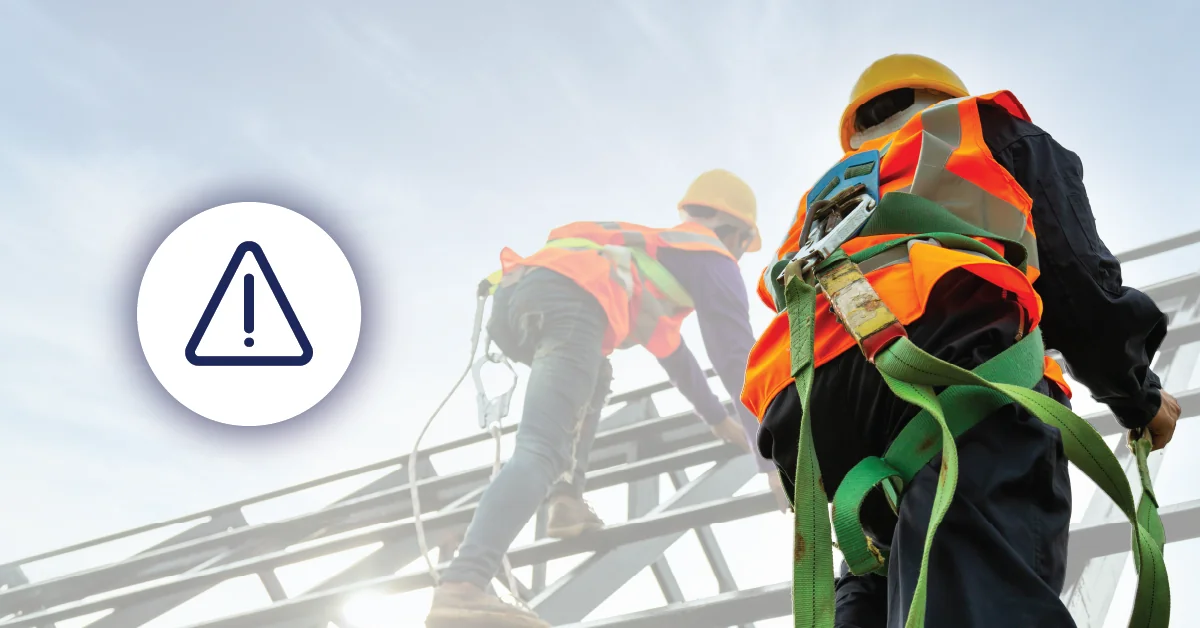“Working at heights” – a term that workers associate with works conducted on scaffolding, ladders, and rooftops – has gradually been reframed as part of a broader discussion on fall risks.
While the tools and tasks may look similar, the understanding of the risks have evolved, as have the expectations on workers and contractors for conducting work safely. And with this evolution comes a renewed need for clarity, responsibility, and safety.
In this article, Cm3 explores the concept of Fall Risks, the importance of compliance, strategies for managing Fall Risks, and how Cm3 is helping to bridge the compliance gap for employers that engage contractors for affected work types.
What Are Fall Risks?
Fall risks encompass any work situation where a person could fall from one level to another, with the potential to result in injury or death. It is not just about rooftops – these risks are present even below ground level if a worker is on an elevated platform.
Some examples of work with fall risks include:
- Work near unprotected edges
- Work on elevated work platforms (EWPs) such as cherry pickers
- Standing on unstable platforms like ladders or boxes
- Climbing machinery or vehicles
- Tasks performed in ceiling cavities
When work is being conducted by contractors, these risks often emerge in temporary setups or ad hoc tasks where traditional safety controls may not be fully in place.
Under Australian WHS regulations, falls from height are treated as a priority risk, requiring employers to eliminate or control such risks wherever reasonably practicable. https://www.safeworkaustralia.gov.au/safety-topic/hazards/working-heights
From “Working at Heights” to Risk-Based Language
The industry is moving from prescriptive checklists to risk-focused approaches. Rather than simply asking, “Are you working at heights?” organisations now assess:
- The likelihood of a fall occurring
- The potential severity of a fall
- The effectiveness of control measures
The objective of this approach is not just about being compliant – but meaningful, proactive safety.
Why Compliance Is Crucial
Workplace falls remain one of the leading causes of traumatic injury in Australia. According to Safe Work Australia:
- Falls account for over 10% of serious workers’ compensation claims annually
- Falls from height saw a 71% increase in fatalities from 2022 to 2024
- Construction, transport, and maintenance sectors are the highest-risk industries
- Many incidents involve temporary or untrained workers
Compliance isn’t a tick-box exercise – it is a moral and legal obligation. Failing to manage fall risks can lead to:
- Prosecution under WHS legislation
- Fines and penalties for organisations and officers
- Loss of reputation and trust
Non-compliance does not have to result in an incident for regulators to issue fines. For example, SafeWork NSW stipulates that “Solar installers face on-the-spot fines of up to $720 for individuals and $3,600 for businesses for not protecting workers from falls from heights and electrical risks.”
Strategies for Managing Fall Risks Effectively
There are numerous ways to boost safety and meet compliance duties when work has the potential for fall risks.
1. Design Out the Risk
If possible, eliminate the need to work at height altogether. Some tactics to address this include:
- Use extendable tools instead of climbing
- Prefabricate components at ground level
- Automate overhead inspections
2. Apply the Hierarchy of Controls
When elimination is not feasible, apply the hierarchy of controls in order of effectiveness:
| Control Type | Example |
| Substitution | Use of scaffolding vs. ladders |
| Engineering | Guardrails, safety mesh |
| Administrative | Permits, signage, supervision |
| PPE | Harnesses, helmets |
3. Training and Supervision
An employer or PCBU cannot simply assume competence. All personnel, including contractors, should be:
- Properly inducted and trained
- Supervised by experienced workers
- Equipped with clear instructions and emergency procedures
4. Monitor and Review
Fall risk controls should be reviewed regularly through:
- Incident investigations
- Toolbox talks and site audits
- Real-time feedback from workers
How Cm3 helps mitigate Fall Risks when engaging contractors
Australia’s approach to workplace safety is built on strong regulatory frameworks. WHS legislation emphasises:
- Duty of care across all levels: PCBU, officers, workers
- Consultation with workers on safety matters
- Ongoing risk assessment and control validation
Yet challenges persist:
- Remote and regional worksites may lack oversight
- Subcontractor management can be inconsistent
- Temporary structures and ad hoc setups can introduce new risks
Cm3’s assessment process and contractor management platform are designed to support organisations in identifying, tracking, and managing contractor risks. This fosters safer supply chains and efficient contractor ecosystems.
When engaging a contractor through Cm3 that conducts work with the potential for Fall Risks, the contractor must complete a prequalification assessment to determine the nature of the work and their preparedness to manage the risks.
These can include:
- Risk Assessments
- Safe Work Method Statements (SWMS)
- Training records
- Equipment inspection records (ladders, scaffolding, etc)
- Fall Risk plans
- High risk licences (where there is potential for falls from over 11 metres)
Additionally, assessments for managing remote work, use of subcontractors, and powered mobile plant are applied with applicable to the nature of the work, providing a comprehensive understanding of a contractor’s capabilities for the work at hand.
Cm3’s visitor management solution, Cm3 OnSite, can also be used to control work site access, deliver important site inductions and ensure that important induction information is delivered and understood by contractors as they arrive on site.
While not a requirement, a Permit To Work for Fall Risks is considered best practice. Cm3 is currently developing a fully digital PTW system that will integrate seamlessly with Cm3 OnSite, providing a streamlined process for raising, reviewing, authorising, and closing out work permits for work with Fall Risks.
If you are a business engaging contractors or managing projects across multiple worksites, Cm3 gives you the tools and confidence to reduce fall risks and go beyond meeting your WHS obligations.
Contact a solutions expert today to learn more.
